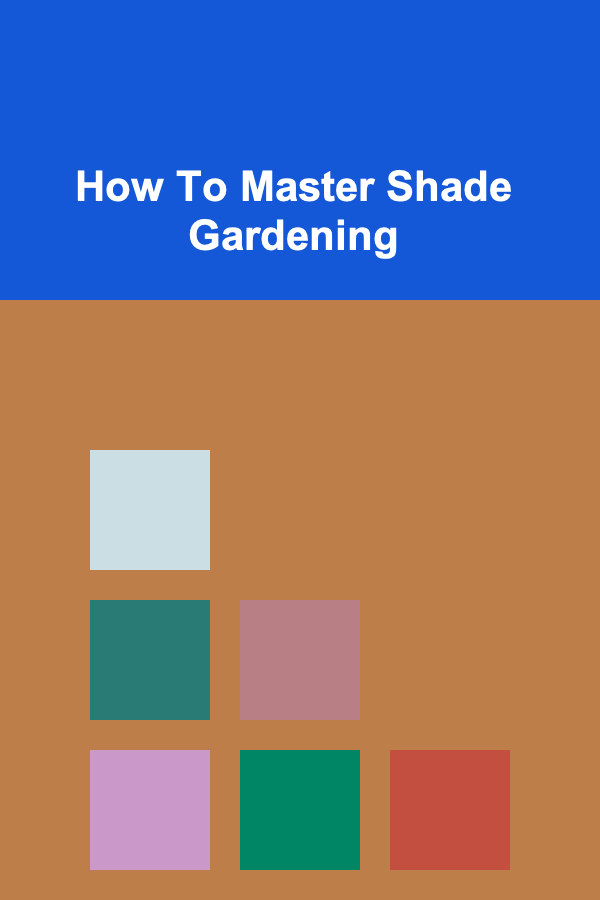
How To Master Shade Gardening
ebook include PDF & Audio bundle (Micro Guide)
$12.99$11.99
Limited Time Offer! Order within the next:

Shade gardening is an art and a science that requires a deep understanding of plants, their growth patterns, and how they interact with the environment. While many gardeners focus on sunny spots for planting, shade gardening offers its own set of challenges and rewards. Whether you're dealing with a heavily shaded garden or just want to create a cool, tranquil retreat, mastering shade gardening can transform even the dullest corners of your yard into lush, thriving spaces.
In this comprehensive guide, we'll explore the key concepts of shade gardening, from understanding different types of shade to selecting the right plants and managing soil and moisture. We'll also offer practical tips on designing and maintaining a shade garden, ensuring that your shaded areas flourish with minimal effort.
Understanding Shade: Types and Characteristics
Before diving into the world of shade gardening, it's essential to understand the different types of shade you may encounter. Shade can vary significantly depending on several factors, such as the time of day, the angle of sunlight, and the presence of structures or trees that cast shadows. Broadly speaking, there are three main types of shade: full shade, partial shade, and dappled or filtered shade.
Full Shade
Full shade refers to areas where plants receive little to no direct sunlight throughout the day. This type of shade typically occurs beneath dense trees with thick canopies or on the north side of buildings. The lack of sunlight in these areas means the soil tends to stay moist, and the light levels are low, making it a challenging environment for many plants.
Full shade doesn't necessarily mean no light at all---plants in full shade may still receive ambient light, but it's not enough for many sun-loving plants to thrive.
Partial Shade
Partial shade refers to areas that receive some direct sunlight, usually for a few hours during the day, but the exposure is less than what full-sun plants receive. Partial shade often occurs in spaces with trees that allow sunlight to filter through, or along the edges of buildings where the light is not as intense.
While partial shade allows more light to reach plants compared to full shade, the intensity of sunlight is still reduced, and careful plant selection is essential.
Dappled or Filtered Shade
Dappled or filtered shade is characterized by sunlight that passes through a canopy of leaves or other structures, creating a shifting pattern of light and shadow. This type of shade is common in areas beneath trees with sparse or open canopies, where sunlight is filtered through the leaves, creating spots of sunlight and shadows throughout the day.
Plants growing in dappled shade receive intermittent sunlight, which can vary in intensity depending on the time of year and the position of the sun.
Choosing the Right Plants for Shade Gardens
Selecting the right plants for your shade garden is crucial to its success. While many plants thrive in full sunlight, there are plenty of species that are well-adapted to shady conditions. Here's a breakdown of some popular plants that can thrive in different types of shade.
Plants for Full Shade
Full shade can be a tricky environment, and only plants that are specifically adapted to low-light conditions will thrive. Many of these plants are native to woodland environments, where they have evolved to survive with minimal sunlight. Some excellent choices for full shade include:
- Hostas: Known for their lush foliage and wide variety of leaf colors and textures, hostas are a staple in shade gardens. They grow well in full shade and offer a range of sizes, from small varieties to large, dramatic plants.
- Ferns: Ferns, including varieties like the Japanese painted fern and the ostrich fern, are well-suited for full shade. Their delicate, feathery fronds add texture and movement to a shaded garden.
- Astilbes: Astilbes are perennial plants that thrive in moist, shaded areas. They are known for their attractive, feathery flower clusters in shades of pink, red, white, and purple.
- Heuchera (Coral Bells): Heuchera offers a variety of leaf colors, from deep purples and reds to silver and green. It's an ideal choice for shaded borders or containers.
- Solomon's Seal: This plant has arching stems with delicate white flowers that appear in spring. Solomon's seal thrives in moist, shaded environments and can create a lovely ground cover.
Plants for Partial Shade
Partial shade areas receive more light than full shade, so you have a wider range of plant options. Plants that thrive in partial shade need protection from the intense afternoon sun but still require a few hours of sunlight. Some excellent choices for partial shade include:
- Bleeding Heart (Dicentra): Known for its unique heart-shaped flowers, bleeding heart grows well in partial shade and adds a touch of elegance to any garden.
- Tiarella (Foamflower): Foamflower is an evergreen perennial with attractive foliage and delicate flowers that bloom in early spring. It grows well in moist, shaded conditions.
- Columbine (Aquilegia): Columbine's beautiful, spurred flowers in shades of purple, red, and yellow thrive in partial shade and attract pollinators like bees and hummingbirds.
- Lobelia: Lobelia is an excellent choice for adding color to a partially shaded garden. The vibrant blue, purple, and white flowers bloom throughout the summer and attract hummingbirds.
- Toad Lily (Tricyrtis): Known for its striking, orchid-like flowers, the toad lily thrives in partial shade and blooms in late summer to fall.
Plants for Dappled or Filtered Shade
Dappled shade is perhaps the most versatile of the three, as many plants enjoy the mix of sunlight and shadow it provides. These plants need protection from the harsh midday sun but can tolerate some direct light. Some excellent choices for dappled shade include:
- Trillium: Trillium is a native wildflower that thrives in dappled shade. It features elegant flowers that come in shades of white, red, or purple and bloom in early spring.
- Virginia Bluebell (Mertensia virginica): This spring-blooming plant produces clusters of bell-shaped flowers in shades of blue and purple. It thrives in dappled shade and adds a lovely early-season bloom to the garden.
- Lungwort (Pulmonaria): Lungwort is a perennial plant that has attractive spotted leaves and produces clusters of pink or blue flowers in early spring. It grows well in dappled shade and is also tolerant of moist soil conditions.
- Jack-in-the-Pulpit (Arisaema triphyllum): This plant has unique flowers with a hood-like structure. It thrives in dappled or filtered shade and adds an intriguing feature to your garden.
- Woodland Phlox (Phlox divaricata): Woodland phlox blooms in shades of purple, pink, or white and adds a sweet fragrance to the shade garden. It thrives in moist, partially shaded environments.
Soil and Moisture Management
Shade gardens often experience different soil conditions compared to sun-drenched areas. Many shady spaces, especially those under trees, have soil that is drier and more acidic. However, it's important to pay attention to soil texture, drainage, and moisture levels to ensure healthy plant growth.
Soil Conditions
Shady areas often have more acidic soil, particularly in areas where pine trees or acidic-loving plants grow. It's crucial to test your soil to understand its pH levels and nutrient content. If your soil is too acidic, consider adding lime to raise the pH, or if it's too alkaline, add organic matter to lower the pH. Most shade-loving plants prefer slightly acidic soil (pH 5.5 to 6.5), but specific plants may have different needs.
Additionally, shady areas often have compacted soil, especially if the ground is covered by tree roots. Adding organic matter such as compost can help improve soil structure and provide the nutrients that your plants need to thrive.
Moisture Management
Many shade gardens experience moist soil conditions due to the lack of sunlight, which prevents rapid evaporation. However, it's important not to overwater, as too much moisture can lead to root rot. It's essential to create well-draining soil by amending it with compost or sand to prevent water from pooling.
If your garden is prone to excess moisture, consider planting moisture-tolerant species such as ferns or astilbes that thrive in these conditions. On the other hand, if you have a dry, shady area, select drought-tolerant plants like hostas or solomon's seal that can handle lower moisture levels.
Designing Your Shade Garden
Designing a shade garden can be incredibly rewarding, but it requires careful planning. Consider factors like color, texture, and plant height to create a visually appealing garden that complements the shaded environment.
Layering for Depth
To add depth to your shade garden, layer plants of varying heights. Taller plants such as ferns and astilbes can be placed at the back, while shorter ground covers like hostas and woodland phlox can fill in the front. By arranging plants in layers, you can create a natural, woodland-like effect that feels lush and inviting.
Adding Structure with Hardscaping
Incorporating hardscaping elements such as pathways, benches, or decorative rocks can add structure to your shade garden. These elements provide visual interest and make the space feel more intentional. Consider using stone paths or wooden benches to complement the natural beauty of your plants.
Incorporating Water Features
Adding a small water feature such as a fountain or birdbath can create a serene atmosphere in your shade garden. The sound of running water can enhance the peaceful ambiance and attract wildlife such as birds and frogs.
Maintenance Tips for Shade Gardens
While shade gardens often require less maintenance than sunny gardens, they still need regular care. Here are a few tips for keeping your shade garden healthy:
- Watering: Water your shade plants deeply, especially during dry spells. However, be mindful not to overwater, as excess moisture can lead to fungal diseases.
- Mulching: Apply a layer of organic mulch around your plants to retain moisture, suppress weeds, and improve soil quality.
- Pruning: Trim back dead or damaged foliage regularly to encourage new growth and maintain a tidy appearance.
- Fertilizing: Fertilize shade plants sparingly, as too much fertilizer can encourage excessive foliage growth at the expense of flowers.
Conclusion
Mastering shade gardening requires patience, knowledge, and creativity. By understanding the different types of shade and selecting the right plants for your environment, you can create a thriving, low-maintenance garden that adds beauty and tranquility to any space. With careful attention to soil, moisture, and design, you can transform your shaded areas into vibrant, lush oases that are a joy to spend time in.

Becoming a Client Relations Manager: Key Skills for Effective Client Engagement
Read More
How to Make a DIY Utensil Holder from Recycled Materials
Read More
How to Organize Your Hobby Collection for Easy Access
Read More
How to Understand ISO for Low Light in Photography
Read More
How To Trace the Origins of Human Civilization
Read MoreHow to Build a Bonus and Incentive Tracker for Multiple Income Streams
Read MoreOther Products

Becoming a Client Relations Manager: Key Skills for Effective Client Engagement
Read More
How to Make a DIY Utensil Holder from Recycled Materials
Read More
How to Organize Your Hobby Collection for Easy Access
Read More
How to Understand ISO for Low Light in Photography
Read More